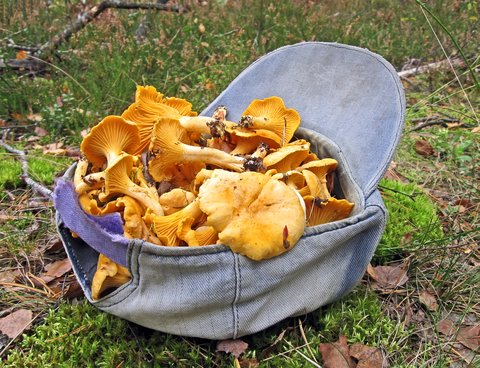
With the coveted morels of springtime all but gone throughout most of the United States, mushroom hunters must turn to other species to satisfy their foraging needs. In the coming months, some of the best species of mushrooms can be found including chanterelles.
In the minds of mushroom hunters above all other summer mushrooms sits the chanterelle, the distinct and aromatic mushroom that can be found in many parts of the country. Not the typical stem-and-cap mushroom that beginners may imagine when thinking of mushrooms, the chanterelle’s somewhat strange appearance will grab your attention from a distance in the woods.
The best part about chanterelles, aside from their delicious taste, is their relative ease of identification for a beginner. Many people are inclined to never even consider mushroom hunting for fear of poisoning, but there are a few species that are so visually distinct that a few quick identification pointers can rule out any lookalikes.
In general, most of the poisonous mushrooms of the world are stem-and-cap shaped, with gills under the cap. Luckily, many of the best mushrooms do not follow this pattern, and rather grow into specimens that don’t look very much like traditional mushrooms at all. Because of their freakish individuality, they are easy to identify.
The chanterelle grows on the ground all over the northern hemisphere in oak woods and various conifer woods, and it appears singly or in scattered groups. It grows to three inches or larger, and the cap is wavy-edged and yellow to yellow-orange
The chanterelle comes in many varieties, from the popular yellow chanterelle to the smooth chanterelle. In California, chanterelles can grow to two or three times the size of those in the Rocky Mountains. Distinguishing characteristics are the forked gills that run down the stem. Instead of a clear point where the gilled-cap meets the non-gilled stem, on the chanterelle the gills run much of the way down the stem and, if examined closely, bear forked sections instead of straight unbroken gills. For the beginner chanterelle hunter, it is okay to think of them as gills, but in reality they are just folds in the mushroom. The smooth chanterelle of the eastern United States looks just like a true chanterelle, but the forked gills are almost non-existent.
The chanterelle is perhaps best known for its strong fruity, apricot-like odor, which is pleasant for the beginner in comparison to some mushrooms that taste amazing but have less than appetizing scents when fresh picked. It is sometimes joked that the chanterelle is one of few mushrooms you can hunt for blindfolded. Also, the pleasant smell doesn’t diminish with preparation and cooking.
The stipe is solid and meaty, so it is important to remember a knife when going on a chanterelle forage. Also, knives are necessary because ripping a mushroom out of the ground can disturb the mycelium in the dirt and prevent more of the same species from growing in that spot in the future. Making a clean cut at the base will ensure that the body of the organism underground is left intact.
Although the chanterelle is fairly easy to identify, it is always worth knowing the species that could be mistaken for it. Everyone’s biggest fear is poisoning, so those species are worth knowing. Become familiar with Deadly Corts and Jack-O-Lanterns. They are easily distinguishable from chantrelles if you have some photos to refer to. Orange milk caps and lobster mushrooms vaguely resemble the chantrelle, but both are edible. The orange milk cap has a distinct point where gills stop at the stem, and the lobster mushroom almost appears like a mushroom that has been sprayed with a orange to red truck bed liner.
If the chanterelle is the first wild mushroom you pick and eat, it may have the adverse effect of ruining other mushrooms for you. You have been warned.
© Fmua | Dreamstime.com – Fresh Edible Yellow Chanterelle Heap In Blue Cap, Photo








